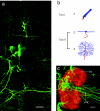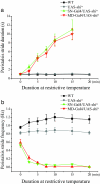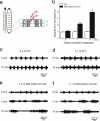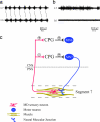Peripheral multidendritic sensory neurons are necessary for rhythmic locomotion behavior in Drosophila larvae
- PMID: 17360325
- PMCID: PMC1820883
- DOI: 10.1073/pnas.0700895104
Peripheral multidendritic sensory neurons are necessary for rhythmic locomotion behavior in Drosophila larvae
Abstract
From breathing to walking, rhythmic movements encompass physiological processes important across the entire animal kingdom. It is thought by many that the generation of rhythmic behavior is operated by a central pattern generator (CPG) and does not require peripheral sensory input. Sensory feedback is, however, required to modify or coordinate the motor activity in response to the circumstances of actual movement. In contrast to this notion, we report here that sensory input is necessary for the generation of Drosophila larval locomotion, a form of rhythmic behavior. Blockage of all peripheral sensory inputs resulted in cessation of larval crawling. By conditionally silencing various subsets of larval peripheral sensory neurons, we identified the multiple dendritic (MD) neurons as the neurons essential for the generation of rhythmic peristaltic locomotion. By recording the locomotive motor activities, we further demonstrate that removal of MD neuron input disrupted rhythmic motor firing pattern in a way that prolonged the stereotyped segmental motor firing duration and prevented the propagation of posterior to anterior segmental motor firing. These findings reveal that MD sensory neuron input is a necessary component in the neural circuitry that generates larval locomotion.
Conflict of interest statement
The authors declare no conflict of interest.
Figures





Similar articles
-
Embryonic assembly of a central pattern generator without sensory input.Nature. 2002 Mar 14;416(6877):174-8. doi: 10.1038/416174a. Nature. 2002. PMID: 11894094
-
Coordination and modulation of locomotion pattern generators in Drosophila larvae: effects of altered biogenic amine levels by the tyramine beta hydroxlyase mutation.J Neurosci. 2006 Feb 1;26(5):1486-98. doi: 10.1523/JNEUROSCI.4749-05.2006. J Neurosci. 2006. PMID: 16452672 Free PMC article.
-
Enhanced locomotion caused by loss of the Drosophila DEG/ENaC protein Pickpocket1.Curr Biol. 2003 Sep 2;13(17):1557-63. doi: 10.1016/s0960-9822(03)00596-7. Curr Biol. 2003. PMID: 12956960
-
Development of larval motor circuits in Drosophila.Dev Growth Differ. 2012 Apr;54(3):408-19. doi: 10.1111/j.1440-169X.2012.01347.x. Dev Growth Differ. 2012. PMID: 22524610 Review.
-
Central pattern generating networks in insect locomotion.Dev Neurobiol. 2020 Jan;80(1-2):16-30. doi: 10.1002/dneu.22738. Epub 2020 Mar 23. Dev Neurobiol. 2020. PMID: 32128970 Review.
Cited by
-
Characterization of Drosophila larval crawling at the level of organism, segment, and somatic body wall musculature.J Neurosci. 2012 Sep 5;32(36):12460-71. doi: 10.1523/JNEUROSCI.0222-12.2012. J Neurosci. 2012. PMID: 22956837 Free PMC article.
-
Adult Drosophila Lack Hematopoiesis but Rely on a Blood Cell Reservoir at the Respiratory Epithelia to Relay Infection Signals to Surrounding Tissues.Dev Cell. 2019 Dec 16;51(6):787-803.e5. doi: 10.1016/j.devcel.2019.10.017. Epub 2019 Nov 14. Dev Cell. 2019. PMID: 31735669 Free PMC article.
-
Live Imaging and Analysis of Muscle Contractions in Drosophila Embryo.J Vis Exp. 2019 Jul 9;(149):10.3791/59404. doi: 10.3791/59404. J Vis Exp. 2019. PMID: 31355800 Free PMC article.
-
Isolation and purification of Drosophil peripheral neurons by magnetic bead sorting.J Vis Exp. 2009 Dec 1;(34):1599. doi: 10.3791/1599. J Vis Exp. 2009. PMID: 19953079 Free PMC article.
-
Drosophila Insulin receptor regulates the persistence of injury-induced nociceptive sensitization.Dis Model Mech. 2018 May 10;11(5):dmm034231. doi: 10.1242/dmm.034231. Dis Model Mech. 2018. PMID: 29752280 Free PMC article.
References
Publication types
MeSH terms
Substances
Grants and funding
LinkOut - more resources
Full Text Sources
Other Literature Sources
Molecular Biology Databases

